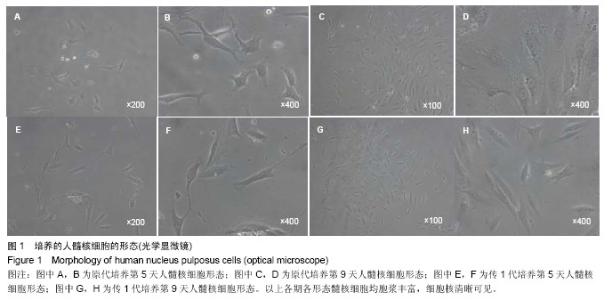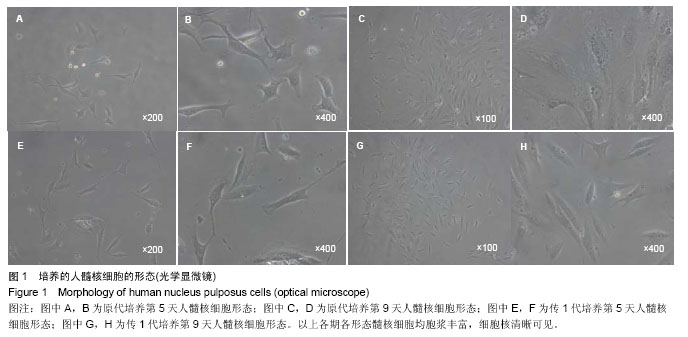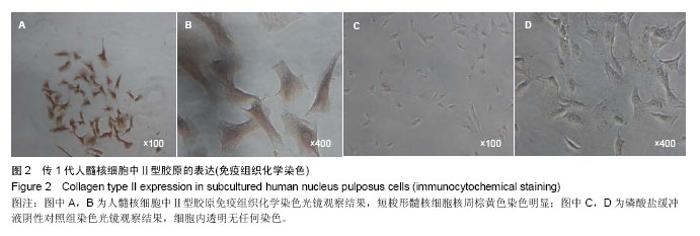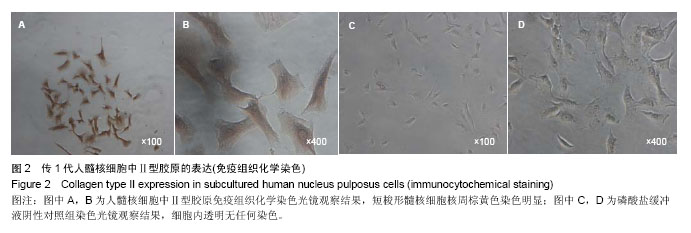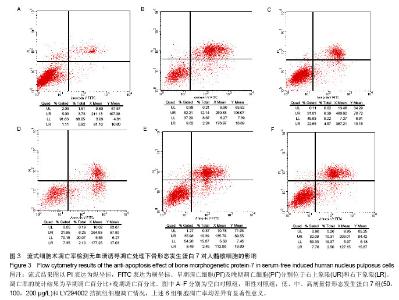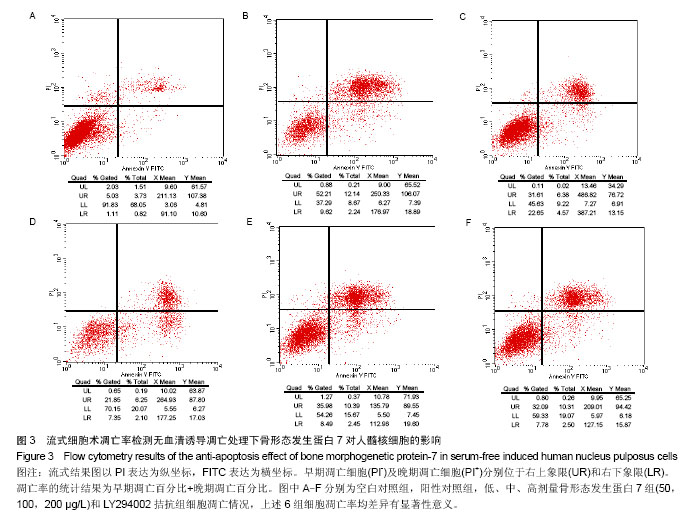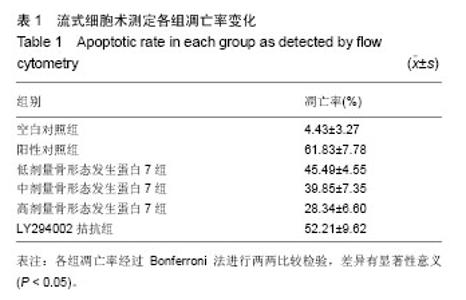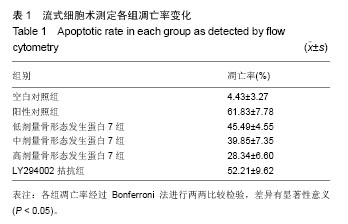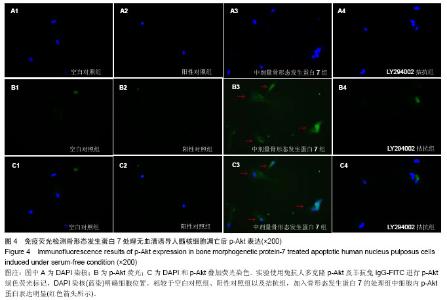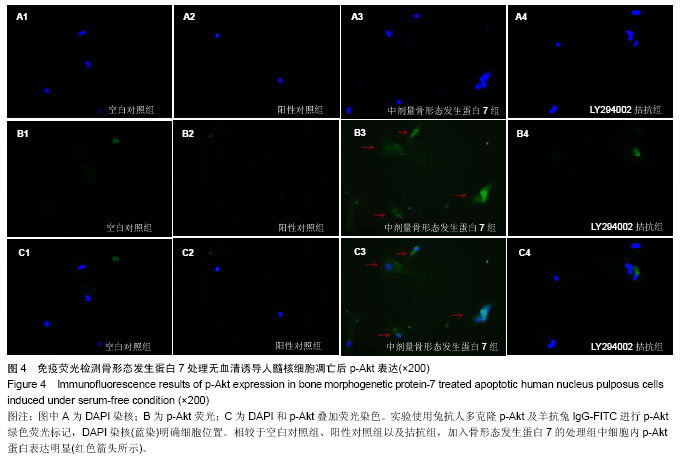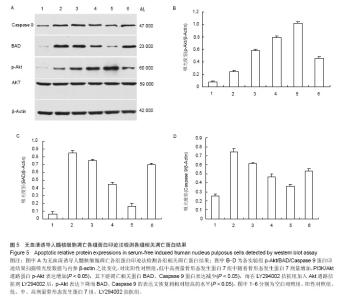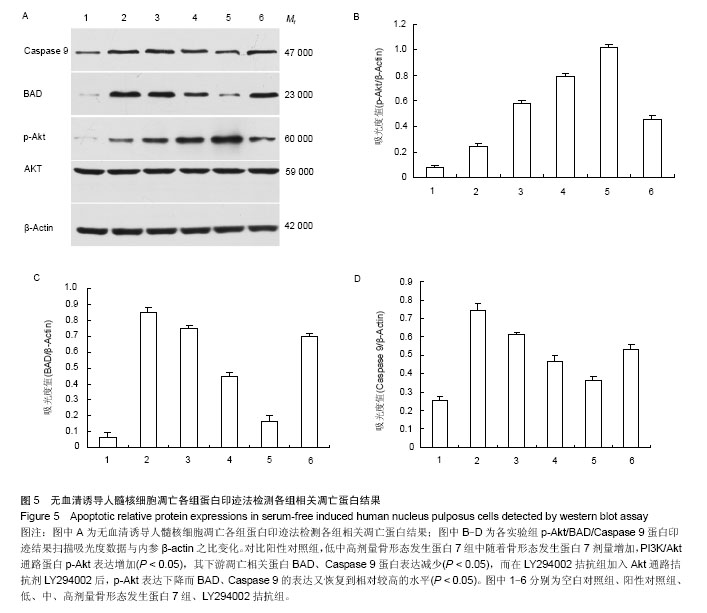Chinese Journal of Tissue Engineering Research ›› 2014, Vol. 18 ›› Issue (24): 3821-3828.doi: 10.3969/j.issn.2095-4344.2014.24.009
Previous Articles Next Articles
Bone morphogenetic protein-7 inhibits apoptosis of human nucleus pulposus cells through activation of PI3K/Akt pathway
Yu Hao-tao, Xu Yi-chun, Wang Qi-you, Ou Ding-qiang, Zhou Wei
- Department of Spinal Surgery, the Third Affiliated Hospital of Sun Yat-sen University, Guangzhou 510630, Guangdong Province, China
-
Revised:2014-05-16Online:2014-06-11Published:2014-06-11 -
Contact:Xu Yi-chun, M.D., Department of Spiny Surgery, the Third Affiliated Hospital of Sun Yat-sen University, Guangzhou 510630, Guangdong Province, China -
About author:Yu Hao-tao, Master, Department of Spinal Surgery, the Third Affiliated Hospital of Sun Yat-sen University, Guangzhou 510630, Guangdong Province, China -
Supported by:Science and Technology Program of Guangdong Province, No. 2009B030801095, 2007A0300005
CLC Number:
Cite this article
Yu Hao-tao, Xu Yi-chun, Wang Qi-you, Ou Ding-qiang, Zhou Wei . Bone morphogenetic protein-7 inhibits apoptosis of human nucleus pulposus cells through activation of PI3K/Akt pathway[J]. Chinese Journal of Tissue Engineering Research, 2014, 18(24): 3821-3828.
share this article
| [1] Kepler CK, Ponnappan RK, Tannoury CA, et al. The molecular basis of intervertebral disc degeneration. Spine J. 2013;13(3):318-330. [2] Vo NV, Hartman RA, Yurube T, et al. Expression and regulation of metalloproteinases and their inhibitors in intervertebral disc aging anddegeneration. Spine J. 2013; 13(3):331-341. [3] Gopal D, Ho AL, Shah A, et al. Molecular basis of intervertebral disc degeneration. Adv Exp Med Biol. 2012; 760:114-33. [4] 王海,黄博,王建,等.退变椎间盘生物学特性研究进展[J]. 中国矫形外科杂志,2013; 21(17):1738-1741. [5] 周旭,贺石生.椎间盘退行性变的分子生物学因素[J].中国组织工程研究,2012,7(39):7375-7379. [6] Ding F, Shao ZW, Xiong LM. Cell death in intervertebral disc degeneration. Apoptosis. 2013;18(7):777-785. [7] Park JB, Lee JK, Park EY, et al. Fas/FasL interaction of nucleus pulposus and cancer cells with the activation of caspases. Int Orthop. 2008;32(6):835-840. [8] Ding F, Shao ZW, Yang SH, et al. Role of mitochondrial pathway in compression-induced apoptosis of nucleus pulposus cells. Apoptosis. 2012;17(6):579-590. [9] Sudo H, Minami A. Caspase 3 as a therapeutic target for regulation of intervertebral disc degeneration in rabbits. Arthritis Rheum. 2011;63(6):1648-1657. [10] 刘旭,车路,王海强,等.椎间盘退变的分子病理机制研究概况[J].中华临床医师杂志(电子版),2013,(6):2664-2666. [11] Wang D, Hu Z, Hao J, et al. SIRT1 inhibits apoptosis of degenerative human disc nucleus pulposus cells through activation of Akt pathway. Age (Dordr). 2013;35(5): 1741-1753. [12] Liu G, Cao P, Chen H, et al. MiR-27a regulates apoptosis in nucleus pulposus cells by targeting PI3K. PLoS One. 2013; 8(9):e75251. [13] Niu CC, Lin SS, Yuan LJ, et al. Hyperbaric oxygen treatment suppresses MAPK signaling and mitochondrial apoptotic pathway in degenerated human intervertebral disc cells. J Orthop Res. 2013;31(2):204-209. [14] Hiyama A, Yokoyama K, Nukaga T, et al. A complex interaction between Wnt signaling and TNF-α in nucleus pulposus cells. Arthritis Res Ther. 2013;15(6):R189. [15] Than KD, Rahman SU, Vanaman MJ, et al. Bone morphogenetic proteins and degenerative disk disease. Neurosurgery. 2012;70(4):996-1002. [16] Wang Z, Hutton WC, Yoon ST. Bone morphogenetic protein-7 antagonizes tumor necrosis factor-α-induced activation of nuclear factor κB and up-regulation of the ADAMTS, leading to decreased degradation of disc matrix macromolecules aggrecan and collagen II. Spine J. 2014;14(3):505-512. [17] 辛洪奎,张超,阮狄克.骨形态发生蛋白7及其对椎间盘退变修复作用的研究进展[J].中国脊柱脊髓杂志,2011,21(5):416-418. [18] Imai Y, Miyamoto K, An HS, et al. Recombinant human osteogenic protein-1 upregulates proteoglycan metabolism of human anulus fibrosus and nucleus pulposus cells. Spine (Phila Pa 1976). 2007;32(12):1303-1309; discussion 1310. [19] Griffith JF, Wang YX, Antonio GE, et al. Modified Pfirrmann grading system for lumbar intervertebral disc degeneration. Spine (Phila Pa 1976). 2007;32(24):E708-E712. [20] Yuan M, Leong KW, Chan BP. Three-dimensional culture of rabbit nucleus pulposus cells in collagen microspheres. Spine J. 2011;11(10):947-960. [21] 王锋,郑陈静美,吴小涛.人退变椎间盘髓核细胞体外平面培养的形态学及活性观察[J].中国矫形外科杂志, 2013,21(13): 1346-1351. [22] Ha KY, Kim BG, Kim KW, et al. Apoptosis in the sequestrated nucleus pulposus compared to the remaining nucleus pulposusin the same patient. Spine (Phila Pa 1976). 2011; 36(9):683-689. [23] Wei A, Brisby H, Chung SA, et al. Bone morphogenetic protein-7 protects human intervertebral disc cells in vitro from apoptosis. Spine J. 2008;8(3):466-474. [24] Yu LP, Qian WW, Yin GY, et al. MRI assessment of lumbar intervertebral disc degeneration with lumbar degenerative disease using the Pfirrmann grading systems. PLoS One. 2012;7(12):e48074. [25] 杨勇,梁伟,罗卓荆,等.不同Pfirrmann分级椎间盘内髓核细胞生物学特性的比较[J].脊柱外科杂志,2011,9(4):244-248. [26] Kakoi H, Maeda S, Shinohara N, et al. Bone morphogenic protein (BMP) signaling up-regulates neutral sphingomyelinase 2 to suppress chondrocyte maturation via the akt protein signaling pathway as a negative feedback mechanism. J Biol Chem. 2014;289(12):8135-8150. [27] Zheng Y, Wang X, Wang H, et al. Bone morphogenetic protein 2 inhibits hepatocellular carcinoma growth and migration through downregulation of the PI3K/AKT pathway. Tumour Biol. 2014. [28] Lim AI, Chan LY, Tang SC, et al. BMP-7 represses albumin-induced chemokine synthesis in kidney tubular epithelial cells through destabilization of NF-κB-inducing kinase. Immunol Cell Biol. 2014. [29] Pei H, Cao D, Guo Z, et al. Bone morphogenetic protein-7 ameliorates cerebral ischemia and reperfusion injury via inhibiting oxidative stress and neuronal apoptosis. Int J Mol Sci. 2013;14(12):23441-23453. [30] Ciumas M, Eyries M, Poirier O, et al. Bone morphogenetic proteins protect pulmonary microvascular endothelial cells from apoptosis by upregulating α-B-crystallin. Arterioscler Thromb Vasc Biol. 2013;33(11):2577-2584. [31] Wang Z, Guo J. Mechanical induction of BMP-7 in osteocyte blocks glucocorticoid-induced apoptosis through PI3K/AKT/ GSK3β pathway. Cell Biochem Biophys. 2013;67(2):567-574. [32] Shimizu T, Kayamori T, Murayama C, et al. Bone morphogenetic protein (BMP)-4 and BMP-7 suppress granulosa cell apoptosis via different pathways: BMP4 via PI3K/PDK-1/Akt and BMP-7 via PI3K/PDK-1/PKC. Biochem Biophys Res Commun. 2012;417(2):869-873. [33] Mehrkens A, Karim MZ, Kim S, et al. Canine notochordal cell-secreted factors protect murine and human nucleus pulposus cells from apoptosis by inhibition of activated caspase-9 and caspase-3/7. Evid Based Spine Care J. 2013; 4(2):154-156. [34] Hiyama A, Yokoyama K, Nukaga T, et al. A complex interaction between Wnt signaling and TNF-α in nucleus pulposus cells. Arthritis Res Ther. 2013;15(6):R189. [35] Ma Y, Qin H, Cui Y. MiR-34a targets GAS1 to promote cell proliferation and inhibit apoptosis in papillary thyroid carcinoma via PI3K/Akt/Bad pathway. Biochem Biophys Res Commun. 2013;441(4):958-963. [36] Iwasaki K, Sudo H, Yamada K, et al. Cytotoxic effects of the radiocontrast agent iotrolan and anesthetic agents bupivacaine and lidocaine in three-dimensional cultures of human intervertebral disc nucleus pulposus cells: identification of the apoptotic pathways. PLoS One. 2014; 9(3):e92442. |
| [1] | Li Jing, Xie Jianshan, Cui Huilin, Cao Ximei, Yang Yanping, Li Hairong. Expression and localization of diacylglycerol kinase zeta and protein kinase C beta II in mouse back skin with different coat colors [J]. Chinese Journal of Tissue Engineering Research, 2021, 25(8): 1196-1200. |
| [2] | Geng Qiudong, Ge Haiya, Wang Heming, Li Nan. Role and mechanism of Guilu Erxianjiao in treatment of osteoarthritis based on network pharmacology [J]. Chinese Journal of Tissue Engineering Research, 2021, 25(8): 1229-1236. |
| [3] | Pei Lili, Sun Guicai, Wang Di. Salvianolic acid B inhibits oxidative damage of bone marrow mesenchymal stem cells and promotes differentiation into cardiomyocytes [J]. Chinese Journal of Tissue Engineering Research, 2021, 25(7): 1032-1036. |
| [4] | Zhao Min, Feng Liuxiang, Chen Yao, Gu Xia, Wang Pingyi, Li Yimei, Li Wenhua. Exosomes as a disease marker under hypoxic conditions [J]. Chinese Journal of Tissue Engineering Research, 2021, 25(7): 1104-1108. |
| [5] | Li Shibin, Lai Yu, Zhou Yi, Liao Jianzhao, Zhang Xiaoyun, Zhang Xuan. Pathogenesis of hormonal osteonecrosis of the femoral head and the target effect of related signaling pathways [J]. Chinese Journal of Tissue Engineering Research, 2021, 25(6): 935-941. |
| [6] | Xu Yinqin, Shi Hongmei, Wang Guangyi. Effects of Tongbi prescription hot compress combined with acupuncture on mRNA expressions of apoptosis-related genes,Caspase-3 and Bcl-2, in degenerative intervertebral discs [J]. Chinese Journal of Tissue Engineering Research, 2021, 25(5): 713-718. |
| [7] | Zhang Wenwen, Jin Songfeng, Zhao Guoliang, Gong Lihong. Mechanism by which Wenban Decoction reduces homocysteine-induced apoptosis of myocardial microvascular endothelial cells in rats [J]. Chinese Journal of Tissue Engineering Research, 2021, 25(5): 723-728. |
| [8] | Liu Qing, Wan Bijiang. Effect of acupotomy therapy on the expression of Bcl-2/Bax in synovial tissue of collagen-induced arthritis rats [J]. Chinese Journal of Tissue Engineering Research, 2021, 25(5): 729-734. |
| [9] | Xie Chongxin, Zhang Lei. Comparison of knee degeneration after anterior cruciate ligament reconstruction with or without remnant preservation [J]. Chinese Journal of Tissue Engineering Research, 2021, 25(5): 735-740. |
| [10] | Su Liping, Lu Ziyang, Liu Li, Zhang Wei, Su Tianyuan, Hu Xiayun, Pu Hongwei, Han Dengfeng. C-jun, Cytc and Caspase-9 in the apoptosis of cerebellar granule neurons induced by diacetylmorphine in rats [J]. Chinese Journal of Tissue Engineering Research, 2021, 25(25): 3943-3948. |
| [11] | Yang Caihui, Liu Qicheng, Dong Ming, Wang Lina, Zuo Meina, Lu Ying, Niu Weidong. Serine/threonine protein kinases can promote bone destruction in mouse models of chronic periapical periodontitis [J]. Chinese Journal of Tissue Engineering Research, 2021, 25(23): 3654-3659. |
| [12] | Zuo Zhenkui, Han Jiarui, Ji Shuling, He Lulu. Pretreatment with ginkgo biloba extract 50 alleviates radiation-induced acute intestinal injury in mice [J]. Chinese Journal of Tissue Engineering Research, 2021, 25(23): 3666-3671. |
| [13] | Zhang Liang, Ma Xiaoyan, Wang Jiahong. Regulatory mechanism of Shenshuai Yin on cell apoptosis in the kidney of chronic renal failure rats [J]. Chinese Journal of Tissue Engineering Research, 2021, 25(23): 3672-3677. |
| [14] | Xie Yang, Lü Zhiyu, Zhang Shujiang, Long Ting, Li Zuoxiao. Effects of recombinant adeno-associated virus mediated nerve growth factor gene transfection on oligodendrocyte apoptosis and myelination in experimental autoimmune encephalomyelitis mice [J]. Chinese Journal of Tissue Engineering Research, 2021, 25(23): 3678-3683. |
| [15] | Xu Bin, Yang Xiushu, Liu Xuan, Wang Zhenxing. Changes of intestinal epithelial cells and their apoptotic factors Caspase-3, Bax and Bcl-2 under urinary environment [J]. Chinese Journal of Tissue Engineering Research, 2021, 25(20): 3173-3177. |
| Viewed | ||||||
|
Full text |
|
|||||
|
Abstract |
|
|||||
